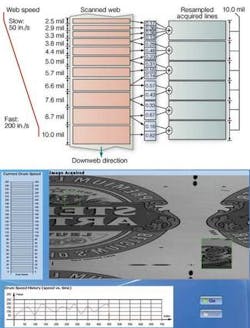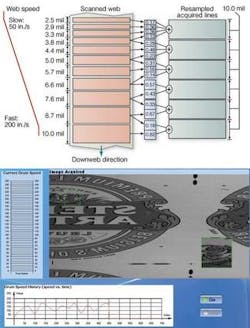Resampling compensates for speed variations
Andrew Wilson, Editor, [email protected]
In web-inspection applications, continuous streams of material such as steel, glass, or paper must be imaged, often at very high speeds. To do this, many system developers use linescan cameras that capture 2-D images based on the motion of the material with respect to the camera. “Traditionally,” says Jean Caron, vice president of customer operations with Euresys (Angleur, Belgium; www.euresys.com), “such linescan cameras image one cross-web line for every camera cycle.
“If, for example, a linescan camera is operating at 10 kHz and the web is moving at 100 in./s, then each scanned line will correspond to a measurement of 1/100 in. in the down-web direction with a resolution of 100 pixels/in. However, if the speed of the web changes, geometrical distortion will occur,” he adds. Traditional approaches to compensate for this effect use a motion encoder that produces a series of pulses that correspond to the speed of the web. A frame grabber with an on-board rate converter then triggers the camera using the output from the motion encoder.
“Unfortunately,” says Caron, “the variable line rate of the camera may have a detrimental effect on the sensitivity of the captured image since a faster camera will use a shorter exposure time and yield a less sensitive response. If no compensation is applied, the brightness of the acquired image in the downward direction will be modulated by the web speed.”
To ensure that the brightness of the acquired image is not controlled by the web speed, linescan-camera manufacturers often use electronic shutters to control the integration times of their cameras. In this way, although the rate of the web and the line rate of the camera may increase or decrease, the exposure time of the camera will remain fixed, ensuring uniformly bright images. The output from the motion encoder must be used to both control the line rate of the camera and its exposure time.
“In some linescan cameras,” says Caron, “manufacturers do not offer an electronic shutter capability, and in most cases, using the shutter degrades the image quality. In these cases, however, captured images still need to maintain uniform sensitivity.” To overcome this problem, Euresys has introduced a new PCI-bus-based Camera Link frame grabber called Grablink Avenue that supports up to 24-bit linescan cameras at up to 85-MHz clock rates. Incorporating the company’s Advanced Downweb Resampling (ADR) technology, this frame grabber can be used with linescan cameras with or without electronic shutters to maintain consistently sensitive images as web speeds may increase or decrease.
In operation, linescan cameras are operated at a fixed rate without an electronic shutter. To measure the speed of motion, a motion encoder is still required but is used to control resampling of the data using a Xilinx (San Jose, CA, USA; www.xilinx.com) FPGA on the Grablink Avenue frame grabber board. For example, a camera running at 20 kHz may monitor a web that changes in speed from 50 to 2000 inches per second (see figure on p. 14). While the top part of the web has been scanned at low-speed, the bottom part has been scanned at the higher rate. Camera data combined with appropriate weights yield an accurate and uniform 100 pixels per inch. To calculate these weights, a patented algorithm using the speed information obtained from the motion encoder is implemented in the FPGA.
“When using the camera in permanent exposure mode, the entire surface to be inspected is imaged, avoiding missed defects,” says Caron. “If the speed of the web is slow, then many more line samples will be obtained than is necessary. But, because the web speed is known, the number of line samples can be weighted on-the-fly in the FPGA to produce the resampled line. Although fewer lines will be acquired if the line speed is slower, those lines can still be weighted to produce the required result,” he adds. “The result is a high-quality image that is uniformly bright and without distortion, no matter what the speed of the web.”

